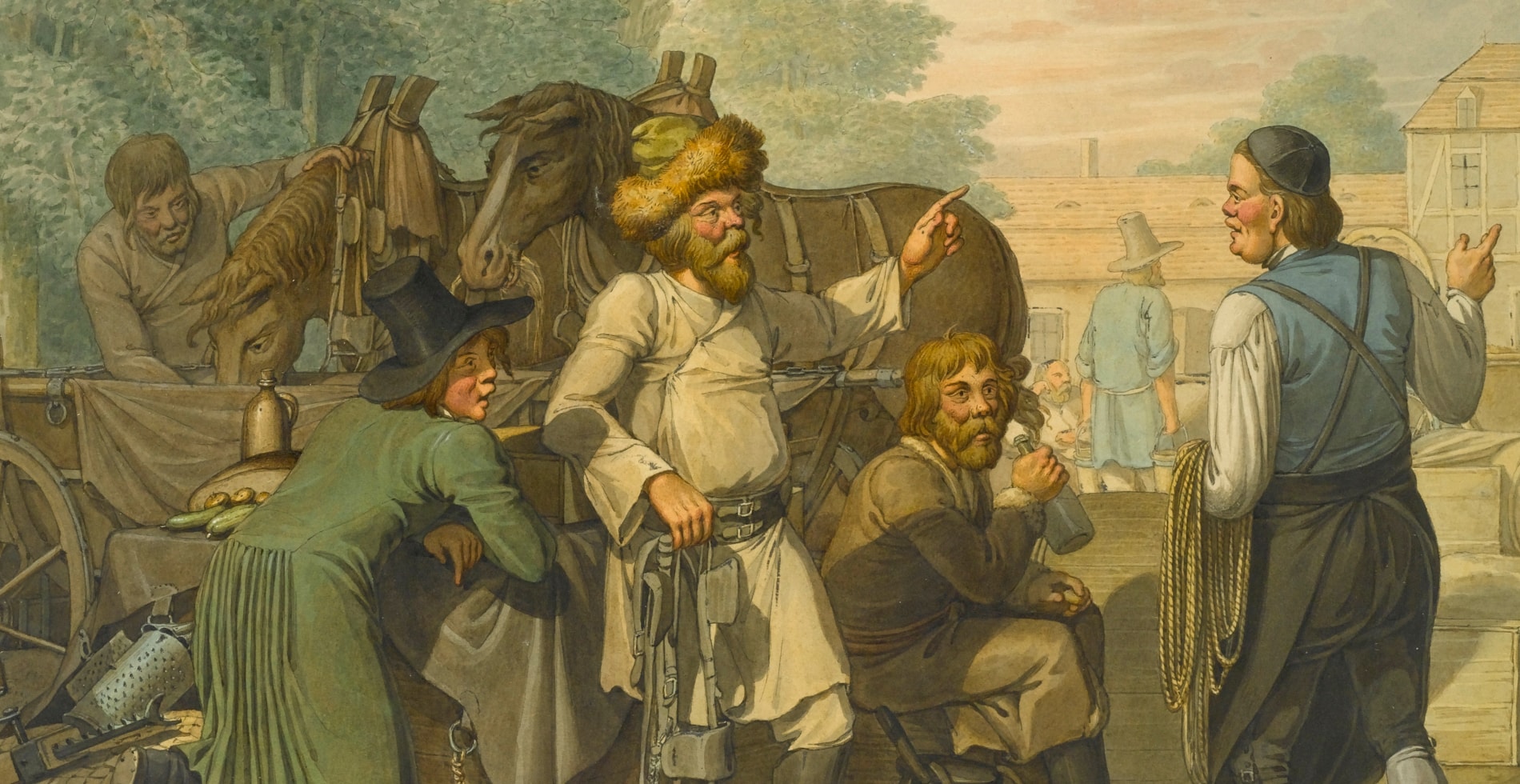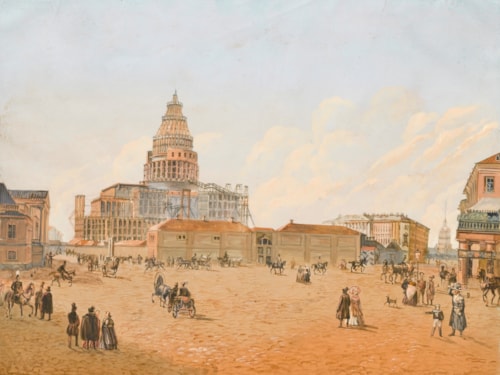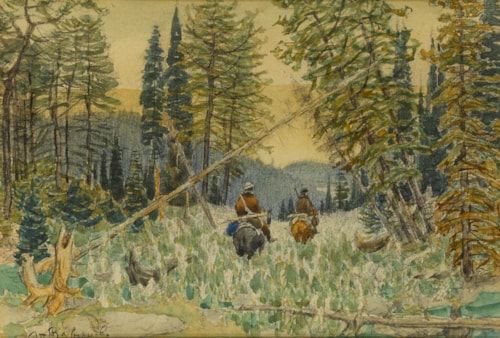eorg Emmanuel Opitz
(Prague 1775 - Leipzig 1841)
Tending to the Horses
indistinctly signed and inscribed 'Opitz....' (lower centre, on the crate)
watercolour over pencil on paper
24 x 28.5 cm (9½ x 11¼ in)
In Tending to the Horses, Georg Emanuel Opitz has depicted a charming scene of rural village life. A man has paused to ask directions from a group of Cossacks, one of whom points him in the right direction. His companions and the young apprentice are in the middle of lunch, and bread and vegetables can be seen on the table by a flask. The Cossacks made their living from tending to horses and one of their number is depicted watering two animals. Cluttered around their stand are various tools of their trade.
Opitz often depicted Russians and Cossacks in his work, most notably in a series of watercolours which shows them trying to adjust to the Parisian lifestyle after their invasion of the city in 1814. Cossack Camp on the Champs-Élysées (Private Collection) is from this series and takes a wry look at the clash of cultures. A gruff and rugged Cossack, dressed in a heavy fur cloak despite the warm sunshine, argues with the contrastingly suave Frenchman. Their argument, which is presumably regarding the sheep and cattle, has attracted a crowd of onlookers and in the background a Russian soldier drinks deeply from his bottle. There are similarities between this work and Tending to the Horses, for example in the depiction of the Cossacks. Opitz depicts them as thickset and bearded with distinctively warm clothing, despite the weather.
There is a humorous tone to Cossack Camp on the Champs-Élysées that is not present in Tending to the Horses, or another scene of simple traders, the British Museum’s Street Scene with Firewood and Poultry Sellers.. However, despite the variety in subject matter, all these watercolours are similar in composition, as illustrated by the British Museum’s picture. The main focus is on the foreground, where a few figures interact; these are painted in strong bold colours which draw the eye. Behind the simple foreground, genre scene figures mill about but they are faintly depicted and do not distract from the central subject.
Born in Prague in 1775, Opitz studied law for a short time before moving to the Academy of Arts in Dresden, where he studied under Giovanni Battista Casanova (1730-1795). In the early part of his career he worked as a portrait painter before moving to Vienna in 1801. It was here that he started to develop as a genre painter, painting scenes of everyday life; although these paintings are often laden with satire and social commentary, their warmth and charm is undeniable. Opitz moved to Paris in 1814 and was there during the occupation of the city by Russian forces. This is why, despite the fact Opitz never set foot in Russia, some of his work reflects a close observation of Russian soldiers and Cossacks. After sojourns in Heidelberg and Altenburg he settled in Leipzig in 1820. There he became a professor at the Academy of Arts and worked for Urania magazine, producing genre works until his death in 1841.
In Tending to the Horses, Georg Emanuel Opitz has depicted a charming scene of rural village life. A man has paused to ask directions from a group of Cossacks, one of whom points him in the right direction. His companions and the young apprentice are in the middle of lunch, and bread and vegetables can be seen on the table by a flask. The Cossacks made their living from tending to horses and one of their number is depicted watering two animals. Cluttered around their stand are various tools of their trade.
Opitz often depicted Russians and Cossacks in his work, most notably in a series of watercolours which shows them trying to adjust to the Parisian lifestyle after their invasion of the city in 1814. Cossack Camp on the Champs-Élysées (Private Collection) is from this series and takes a wry look at the clash of cultures. A gruff and rugged Cossack, dressed in a heavy fur cloak despite the warm sunshine, argues with the contrastingly suave Frenchman. Their argument, which is presumably regarding the sheep and cattle, has attracted a crowd of onlookers and in the background a Russian soldier drinks deeply from his bottle. There are similarities between this work and Tending to the Horses, for example in the depiction of the Cossacks. Opitz depicts them as thickset and bearded with distinctively warm clothing, despite the weather.
There is a humorous tone to Cossack Camp on the Champs-Élysées that is not present in Tending to the Horses, or another scene of simple traders, the British Museum’s Street Scene with Firewood and Poultry Sellers.. However, despite the variety in subject matter, all these watercolours are similar in composition, as illustrated by the British Museum’s picture. The main focus is on the foreground, where a few figures interact; these are painted in strong bold colours which draw the eye. Behind the simple foreground, genre scene figures mill about but they are faintly depicted and do not distract from the central subject.
Born in Prague in 1775, Opitz studied law for a short time before moving to the Academy of Arts in Dresden, where he studied under Giovanni Battista Casanova (1730-1795). In the early part of his career he worked as a portrait painter before moving to Vienna in 1801. It was here that he started to develop as a genre painter, painting scenes of everyday life; although these paintings are often laden with satire and social commentary, their warmth and charm is undeniable. Opitz moved to Paris in 1814 and was there during the occupation of the city by Russian forces. This is why, despite the fact Opitz never set foot in Russia, some of his work reflects a close observation of Russian soldiers and Cossacks. After sojourns in Heidelberg and Altenburg he settled in Leipzig in 1820. There he became a professor at the Academy of Arts and worked for Urania magazine, producing genre works until his death in 1841.





 contact
contact contact
contact +44 20 7313 8040
+44 20 7313 8040









